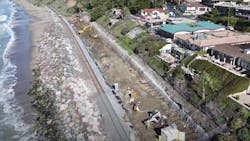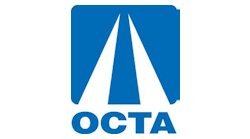Orange County Transportation Authority (OCTA) outlined a two-phase study to assess long-term solutions to preserve service along its line that traverses the coast and has experienced unstable track from erosion. OCTA and partners continue to work on emergency track stabilization work on the tracks near San Clemente.
While work continues on the emergency repairs, OCTA’s proposed framework would cost and estimated $7 million to further study and understand the issues behind the coastal erosion, as well as explore solutions, including potentially moving the rail line, that would allow for rail traffic to continue moving safely.
“When we began the emergency stabilization effort, it was clear that we needed to address the immediate issues first and also to speed up the process of working with all stakeholders to find longer-term solutions,” said OCTA Chairman and Yorba Linda Mayor Gene Hernandez. “I’m pleased to see this comprehensive effort moving forward.”
An estimated $2 million Phase 1 study would examine short- to medium-term solutions to the rail line’s challenges and would aim to:
- Develop strategies to safeguard coastal rail infrastructure at varying sea levels;
- Obtain a more comprehensive understanding of the impact of climate change on the rail line;
- Identify potential solutions to combat beach erosion and
- Engage with important stakeholders and agencies throughout the process.
OCTA has identified grant funding to support Phase 1 of the study. Phase 2’s estimated price tag of $5 million remains unfunded. However, should funding be identified, both phases could be conducted simultaneously with Phase 2’s goals being:
- Collaborate with LOSSAN, state and federal agencies;
- Develop options to protect or relocate the rail line;
- Create an action plan and
- Consult and engage with residents and key stakeholders throughout the study.
“We appreciate the support we’ve already seen, especially from the state, and we look forward to continuing to work together to develop long-term solutions and to keep trains running safely,” Chairman Hernandez said. “This is a critical link in Southern California’s rail network. Addressing both the current emergency situation and planning for our rail future, are top priorities for the OCTA Board of Directors.”
OCTA emergency work continues
OCTA crews continue their work along a 700-foot section of rail line in south San Clemente. OCTA reports the track has stopped shifting following installation of the first row of ground anchors in late January. With the track stable, Amtrak’s Pacific Surfliner, operated by the LOSSAN Rail Authority, resumed weekend passenger service on Feb. 4.
A second row of ground anchors and tie-backs are being installed to further secure the hillside. Once this work is complete, OCTA and Metrolink anticipate returning passenger trains to service along this section of track by April.




